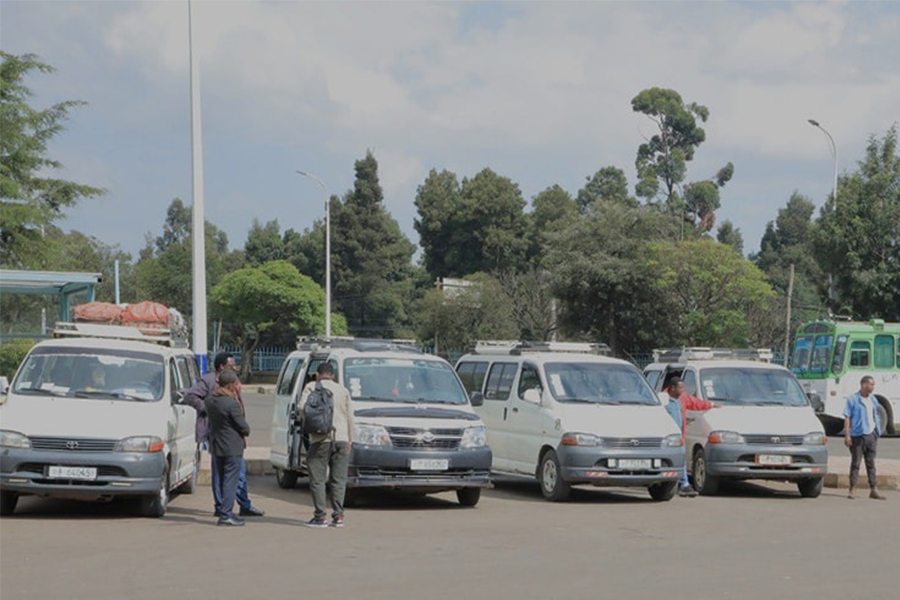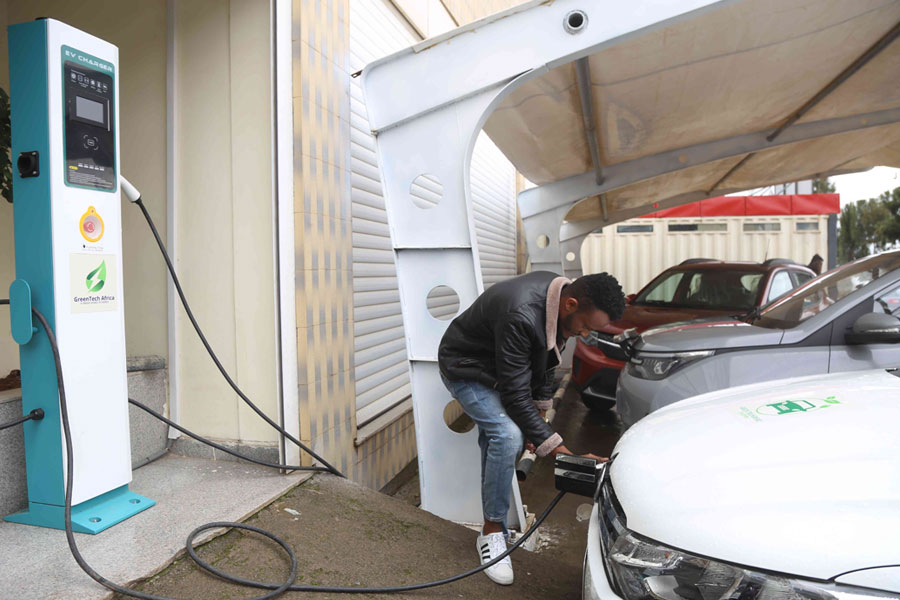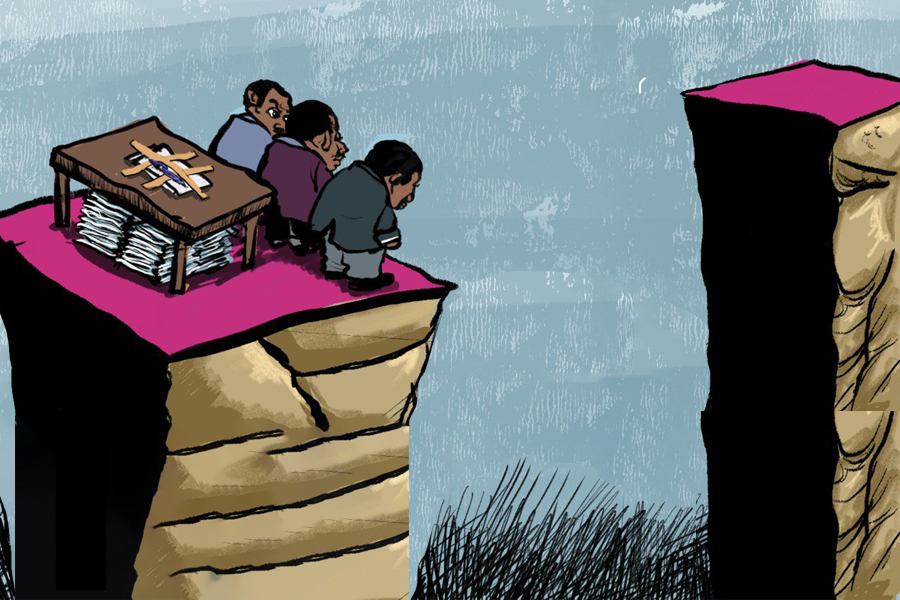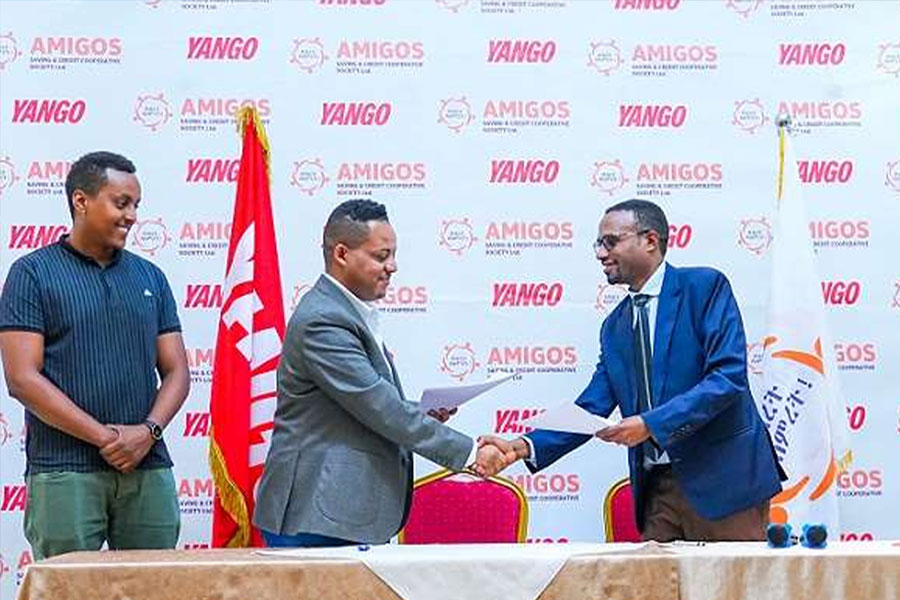
On a gray Tuesday last month, passengers at the Stadium taxi terminal wait in line to take taxis to their destinations, while others just listen to the destinations that are being called out.
The rest are engaged in conversations with station coordinators asking where they can find taxis to where they are going. The station deploys taxis to Torhailoch, Ayer Tena, Arat Kilo, Qera and Autobus Tera.
Fekadu Mengistu, 43, married and a father of three, is a taxi driver who mostly works on a route from Qera to Stadium passing through Lancha. He was picking up passengers who were travelling to Qera from the Stadium terminal.
Fekadu enjoys his profession when he works on his current route, since Stadium has its own taxi terminal. Taxi drivers work on different routes depending on the deployment schedule of the city’s Transport Bureau.
"It is easy for us to pick up and drop off passengers," he said. "It is also convenient to load and unload passengers by waiting our turn."
He also says that the terminal eases things for both the drivers and passengers, since passengers are not exposed to unnecessary crowding and theft.
Where there are no terminals, taxis are often forced to double park on the road, overlapping other taxis when they pick up and drop off passengers, according to him.
"We'll be fined for that if there are traffic police around," he said.
While having 5,058 code one taxis travelling to 292 destinations and 8,031 code three mini-buses travelling to 370 destinations, the city has only five terminals across 10 districts.
Megenagna, Torhailoch, Ayertena, Stadium and Piassa are the five areas where taxi terminals are located. In the remaining districts, taxis pick up and unload passengers on the street.
Recently, a reconstructed terminal of taxi and bus at Megenagna area. Buses passing by the terminal easily.
Meron Bogale, transport facility development administration officer at the Addis Abeba City Transport Authority, admits this.
“As a capital city, the attention given to transportation services is very low," she said.
Near Legehar, 200m away from the Stadium terminal, there is often a taxi lineup at the edge of the asphalt. The taxis double park there to drop off passengers and call to pick up others.
Higer buses, which are not typically in the lineup for the Megenagna route, also contribute to the traffic jam.
Dejene Haile, 39, a married father of four who has worked as a coordinator in the Stadium area since 2010, also witnesses the crowding created by the taxis.
"When there is a terminal, we can easily coordinate passengers to make a queue when there is a shortage of taxis and avoid unnecessary crowding," he said.
Unavailability of terminals has also made the work of traffic police quite difficult, according to Daniel Belete, a traffic police officer who was assisting at the Megenagna roundabout three weeks ago.
"Taxis that are loading and unloading passengers on the right side of the road are complicating the traffic flow," he said. "It can also cause a traffic accident."
In the last fiscal year, the city had 29,548 traffic accidents. Market and residential areas comprised 8,213 and 7,323 accidents, respectively.
On top of the shortage of the terminals, the existing ones are not properly utilised, according to Ahmed Mohammed (Com.), head of Addis Abeba City Administration Transport Authority.
Taxis forced to double park on the road, overlapping other taxis and complicating the traffic flow on Eden Street of piazza which lacks a bay to pick up and drop of passengers.
"Many people leave their cars parked at the areas designated to be terminals," he said.
Ahmed suggested bays that enable taxis to drop off and pick up passengers should be constructed on the sides of roads.
The problem is already recognised by the City Administration, which is attempting to build more terminals in the capital.
For the construction of the terminals, the city's Transport Authority has requested land from the Land Management Office at Bole Bulebula, Bole Arabesa, Yeka Ayat, Gelan Condominium, Alem Bank and Yeka Abado to build taxi terminals, according to Meron.
But still getting land for taxi terminals is a challenge, according to her.
"The City Administration is not willing to give us space for terminals," she said. "The major issues for this are the city’s master plan, shortage of land in the city and social impacts caused by displacing the public to build the terminals."
Recently, the city's Transport Bureau has constructed a terminal at Megenagna. Taxis that pick up passengers travelling to Qaliti, Kazanchise, Mesiko, Ayat, Semit and Merkato use this terminal, easing the jam and hassle in the area.
Constructing the terminals is also very challenging, according to Ahmed.
"Residents in the area designated for parking usually don't cooperate in being relocated from the area," he said.
The city's Roads Authority is also considering taxi terminals and bays while constructing new roads, according to Tieumay Woldegebriel, communications director at the Addis Abeba City Roads Authority.
One of the roads under construction with a taxi terminal is a road that stretches from Lamberet to Kotebe.
"The Authority has considered building a bay, and we are working on widening and constructing a bay on the already existing roads too," Tieumay said.
However, constructing bays or terminals on the existing roads is very difficult, according to Tieumay.
"We can't simply bulldoze buildings by the side of roads to widen the road and construct terminals and bays," he said. "The suitability of the road and demarcation are also the major challenges for the roads we consider to build terminals.”
Fekadu Gurmessa (PhD), a transport geography lecturer at Addis Abeba University for more than a decade, also shares the difficulty of constructing terminals in the city.
"It is difficult to construct terminals, but the City Administration can at least construct bays on the sides of roads to ease the flow,” he said.
Meron at the City Transport Authority says that the sustainable solution in solving the problem is introducing and expanding mass transport.
Since buses can transport more passengers than five taxis, which reduces fuel consumption, it has a positive impact on minimising traffic congestion, according to her.
"However, it doesn’t mean that taxis will be out of service, but gradually we are working on upgrading the capacity of mass transport," she added.
Fekadu concurs. Addis Abeba is a crowded and high-density population city, he said.
"The responsible government body should have to look where the real problems are,” Fekadu said. “It’s better to use a high-occupancy vehicle as a solution. If there are good transport services, people won’t buy cars.”
PUBLISHED ON
Sep 14,2019 [ VOL
20 , NO
1011]

View From Arada | Dec 09,2023

View From Arada | Jun 11,2022

Radar | Sep 29,2024

Radar | Dec 26,2020

Fortune News | Feb 25,2023

Viewpoints | Oct 16,2020

Editorial | Nov 11,2023

Agenda | Jun 21,2025

Radar | May 03,2025

Radar | Nov 07,2020

Dec 22 , 2024 . By TIZITA SHEWAFERAW
Charged with transforming colossal state-owned enterprises into modern and competitiv...

Aug 18 , 2024 . By AKSAH ITALO
Although predictable Yonas Zerihun's job in the ride-hailing service is not immune to...

Jul 28 , 2024 . By TIZITA SHEWAFERAW
Unhabitual, perhaps too many, Samuel Gebreyohannes, 38, used to occasionally enjoy a couple of beers at breakfast. However, he recently swit...

Jul 13 , 2024 . By AKSAH ITALO
Investors who rely on tractors, trucks, and field vehicles for commuting, transporting commodities, and f...

Oct 18 , 2025
The political establishment, notably the ruling party and its top brass, has become p...

Oct 11 , 2025
Ladislas Farago, a roving Associated Press (AP) correspondent, arrived in Ethiopia in...

Oct 4 , 2025
Eyob Tekalegn (PhD) had been in the Governor's chair for only weeks when, on Septembe...

Sep 27 , 2025
Four years into an experiment with “shock therapy” in education, the national moo...